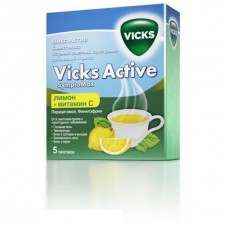Expiration date: 05/2026
Dosage and administration
Adults and children over 12 years: 1 sachet
If necessary, repeat the reception every 4-6 hours, but no more than 4 doses (bags) per day.
The maximum daily dose is 4 sachets.
The maximum duration of the drug without consulting a doctor is not more than 5 days.
Dissolve the contents of one bag in hot, but not boiling water (250 ml).
Allow to cool to an acceptable temperature.
Drink.
Indications for use
Symptoms of "colds" and flu:
- Headache.
- Sore throat.
- Pain in the body and limbs.
- Nasal congestion.
- Cough with difficult expectoration of viscous sputum.
- Elevated body temperature.
Form release
Powder for preparation of oral solution
4, 36 g powder in laminated bag. 5 or 10 sachets together with the instructions for use are placed in a cardboard pack.
Storage conditions
Store at a temperature not exceeding 25°C.
Shelf life: 3 years.
Keep out of reach of children.
Do not use after expiry date.
Composition:
In 4, 36 g of powder for the preparation of oral solution contains:
Active ingredients: Paracetamol 500 mg, Guaiphenesin 200 mg, Phenylephrine hydrochloride 12, 2 mg.
Excipients: Sucrose 2000 mg, citric acid 330 mg, tartaric acid 330 mg, sodium cyclamate, 200 mg sodium citrate 500 mg, aspartame 6 mg, Acesulfame potassium, 17 mg, lemon flavour 8476 - 50 mg, flavor lemon juice 120 mg, flavor menthol 100 mg, dye hinolinovy yellow 1 mg.
Pharmacokinetics
Paracetamol
Paracetamol is rapidly and completely absorbed in the small intestine. C max in the blood is observed 15-20 minutes after ingestion. Systemic bioavailability is determined by presystemic metabolism and, depending on the dose, ranges from 70% to 90%. Paracetamol is rapidly spread over all tissues of the body and has T 1/2 for approximately 2 hours. It is metabolized in the liver and excreted in the urine as glucuronides and sulfate compounds (>, 80%).
Guaifenesin
Quickly absorbed after ingestion. The half-life of 1 h. Metabolized in the liver by oxidation to (2 methoxy-phenoxy) lactic acid, which is excreted through the lungs (sputum) and by the kidneys as inactive metabolites.
Phenylephrine
Phenylephrine is rapidly absorbed from the gastrointestinal tract. The level of primary metabolism is quite high (~ 60%), so the oral use of phenylephrine reduces its bioavailability (~ 40%). C max observed after 1-2 hours, and T 1/2 varies from 2 to 3 hours. Excreted in the urine in the form of sulfate compounds. Oral administration of phenylephrine as a decongestant should be carried out at intervals of 4 to 6 hours.
Clinical pharmacology
Combined drug, the effect of which is due to the composition of its components.
Paracetamol
It has analgesic and antipyretic effect, these effects are due to inhibition of prostaglandin synthesis in the Central nervous system.
Guaifenesin
It has a mucolytic effect, facilitates the removal of phlegm from the bronchi and promotes the transition of unproductive cough into productive.
Phenylephrine
Postsynaptic agonist of alpha-adrenoceptors with low cardioselective affinity for beta - receptors. Decongestant, narrows blood vessels, eliminates swelling and hyperemia of the nasal mucosa.
Contraindications:
- Hypersensitivity to paracetamol or other components of the drug.
- Violation of liver function and severe renal dysfunction.
- Arterial hypertension.
- Hyperthyroidism.
- Diabetes.
- Phenylketonuria (since the drug contains aspartame).
- Ischemic heart disease (CHD) is a pathological condition characterized by myocardial damage as a result of its insufficient absolute or relative blood supply. In fact, coronary heart disease develops as a result of the discrepancy between the amount of oxygen supplied to the metabolic needs of the myocardium.
- Acute myocardial infarction.
- Atherosclerosis of the coronary arteries.
- Aortic stenosis.
- Tachyarrhythmia.
- Simultaneous administration of beta-blockers, tricyclic antidepressants, MAO monoamine oxidase inhibitors, including within 14 days after their withdrawal.
- Peptic ulcer of the stomach and duodenum in the acute stage.
- Prostatic hyperplasia.
- Glaucoma.
- Age up to 12 years.
- Pregnancy.
- The period of breastfeeding.
- A deficiency of sucrase-isomaltase .
- Fructose intolerance.
- Glucose-galactose malabsorption .
With caution:
- Deficiency of glucose-6-phosphate dehydrogenase.
- Bronchial asthma.
- COPD (chronic obstructive pulmonary disease).
- Blood disease.
Congenital hyperbilirubinemia:
- Gilbert's Syndrome .
- Dabin-Johnson Syndrome .
- The Syndrome Of The Rotor .
- Use during pregnancy and breast-feeding
- Do not use the drug during pregnancy and breastfeeding.
Side effect
Paracetamol
- Allergic reaction
- Rarely - skin rash, urticaria, anaphylaxis, bronchospasm, angioedema.
- From the Central nervous system
- Rarely-Dizziness
From the hematopoietic system
- Rarely-aplastic anemia, methemoglobinemia, increased blood pressure . Very rare-pathological changes in the blood, such as thrombocytopenia, Agranulocytosis
From the digestive system
- Rarely-nausea and vomiting , dryness of the oral mucosa, hepatotoxic effect.
- From the urinary system
- Rarely-urinary retention, nephrotoxicity (papillary necrosis).
- Other
- Rarely-accommodation paresis, increased intraocular pressure, Mydriasis
- Guaifenesin
- From the nervous system
- Rarely-headache, dizziness and drowsiness.
- From the digestive system
- Rarely - discomfort in the gastrointestinal tract, nausea, vomiting and diarrhea.
Phenylephrine
- On the part of the cardiovascular system
- Rarely-tachycardia, increased blood pressure.
- From the nervous system
- Rarely - Insomnia
- From the digestive system
- Often-Anorexia
From the immune system and skin
- Rarely-allergic reactions, including skin rash, urticaria, anaphylaxis and bronchospasm.
Overdose:
Paracetamol
Symptoms: an overdose of paracetamol in the first 24 hours-pale, nausea and vomiting
Liver damage may occur in the period from 12 to 48 hours after the drug.
Liver damage is possible in adults who have taken 10 or more grams of paracetamol. The intake of 5 or more grams of acetaminophen can cause liver damage if you have risk factors: prolonged treatment with carbamazepine , phenobarbital , phenytoin , primidon , rifampicin or other drugs that induce liver enzymes, alcohol abuse, lack of glutamine (e.g., poor diet), cystic fibrosis , HIV infection, starvation, cachexia.
Symptoms may be only partially manifested in the form of nausea or vomiting, and may not reflect the actual degree of overdose or the risk of organ damage.
In severe overdose-liver failure with progressive encephalopathy, coma, death, acute renal failure with tubular necrosis (including in the absence of severe liver damage), arrhythmia, pancreatitis .
Treatment: in the case of an overdose of paracetamol, despite the absence of primary symptoms of overdose, it is necessary to seek qualified help in medical institutions. To prevent the serious consequences of overdose, it is necessary to take the necessary measures in a timely manner.
Guaifenesin
Symptoms: a small and moderate overdose can cause dizziness, gastrointestinal disorder (nausea, vomiting and diarrhea).
Very high overdose can cause an excited state, confusion and respiratory depression.
Treatment: gastric lavage, activated charcoal, acetylcysteine (paracetamol antidote), symptomatic therapy.
Phenylephrine
Symptoms: irritability, headache, increased blood pressure . In case of the above symptoms of overdose, you should contact your doctor.
Treatment: the introduction of aid donors SH-groups and precursor to the synthesis of glutathione - methionine for 8 - 9 hours after the overdose and acetylcysteine is within 8 hours. The need for additional therapeutic measures (further administration of methionine, intravenous administration of acetylcysteine) is determined depending on the concentration of paracetamol in the blood, as well as the time elapsed after its reception.
Precautionary measures
Avoid concomitant use of the drug with other paracetamol-containing drugs, as this may cause an overdose of paracetamol.
When using the drug for more than 5 days, peripheral blood parameters and the functional state of the liver should be monitored.
The drug distorts the results of laboratory tests that evaluate the concentration of glucose and uric acid in plasma .
It is necessary to take into account patients, adhering to the sodium diet: the drug contains sodium.
Contains aspartame (E 951), a source of phenylalanine. May be toxic to patients with phenylketonuria.
The drug should not be combined with ethanol .
Application in violation of liver function
Contraindicated in violation of liver function.
Use in renal impairment
Contraindicated in severe renal dysfunction.
Use in children
Contraindicated in children under 12 years.
Impact on the ability to drive and operate machinery
When driving and engaging in other potentially hazardous activities, it is important to take into account that the drug may cause side effects such as dizziness



